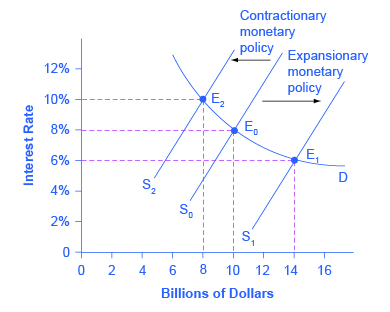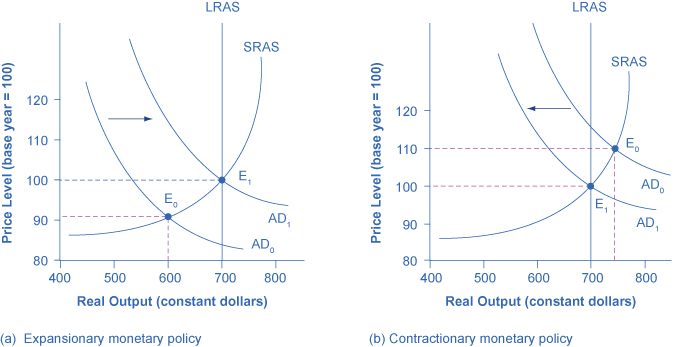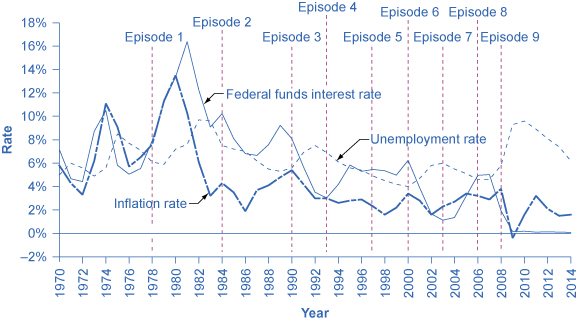What Is Tight Fiscal Policy Loose Money
Affiliate 28. Budgetary Policy and Depository financial institution Regulation
28.4 Monetary Policy and Economic Outcomes
Learning Objectives
By the end of this department, you will be able to:
- Contrast expansionary monetary policy and contractionary monetary policy
- Explicate how monetary policy impacts interest rates and aggregate demand
- Evaluate Federal Reserve decisions over the last twoscore years
- Explain the significance of quantitative easing (QE)
A monetary policy that lowers involvement rates and stimulates borrowing is known equally an expansionary monetary policy or loose monetary policy. Conversely, a monetary policy that raises interest rates and reduces borrowing in the economic system is a contractionary budgetary policy or tight monetary policy. This module will hash out how expansionary and contractionary monetary policies impact involvement rates and aggregate need, and how such policies volition impact macroeconomic goals like unemployment and inflation. Nosotros will conclude with a wait at the Fed'due south monetary policy practice in recent decades.
The Upshot of Monetary Policy on Interest Rates
Consider the market for loanable bank funds, shown in Figure i. The original equilibrium (Eastward0) occurs at an interest rate of eight% and a quantity of funds loaned and borrowed of $10 billion. An expansionary budgetary policy will shift the supply of loanable funds to the right from the original supply bend (S0) to Si, leading to an equilibrium (Eastward1) with a lower interest rate of six% and a quantity of funds loaned of $14 billion. Conversely, a contractionary monetary policy will shift the supply of loanable funds to the left from the original supply curve (S0) to Due south2, leading to an equilibrium (E2) with a college involvement rate of x% and a quantity of funds loaned of $8 billion.

So how does a cardinal depository financial institution "raise" interest rates? When describing the monetary policy actions taken by a key banking concern, it is common to hear that the cardinal bank "raised interest rates" or "lowered interest rates." We need to exist articulate virtually this: more precisely, through open market place operations the cardinal bank changes bank reserves in a mode which affects the supply curve of loanable funds. Every bit a result, interest rates change, as shown in Figure 1. If they do not meet the Fed'south target, the Fed can supply more or less reserves until interest rates exercise.
Recall that the specific involvement rate the Fed targets is the federal funds rate. The Federal Reserve has, since 1995, established its target federal funds rate in advance of any open up market operations.
Of grade, financial markets display a broad range of interest rates, representing borrowers with unlike chance premiums and loans that are to exist repaid over unlike periods of fourth dimension. In general, when the federal funds rate drops substantially, other involvement rates drop, also, and when the federal funds rate rises, other interest rates ascent. However, a fall or rise of one percent betoken in the federal funds charge per unit—which think is for borrowing overnight—will typically have an effect of less than one percentage point on a 30-year loan to purchase a house or a 3-year loan to purchase a car. Monetary policy can push button the entire spectrum of interest rates college or lower, just the specific interest rates are prepare by the forces of supply and demand in those specific markets for lending and borrowing.
The Result of Monetary Policy on Aggregate Demand
Monetary policy affects involvement rates and the bachelor quantity of loanable funds, which in plough affects several components of aggregate demand. Tight or contractionary monetary policy that leads to higher interest rates and a reduced quantity of loanable funds will reduce two components of aggregate demand. Business investment will reject because it is less bonny for firms to borrow money, and even firms that take money will notice that, with higher interest rates, it is relatively more attractive to put those funds in a financial investment than to brand an investment in physical capital. In add-on, college interest rates will discourage consumer borrowing for big-ticket items like houses and cars. Conversely, loose or expansionary monetary policy that leads to lower involvement rates and a college quantity of loanable funds volition tend to increase business investment and consumer borrowing for large-ticket items.
If the economic system is suffering a recession and high unemployment, with output below potential Gross domestic product, expansionary monetary policy tin aid the economy return to potential GDP. Figure 2 (a) illustrates this situation. This example uses a brusk-run upward-sloping Keynesian aggregate supply bend (SRAS). The original equilibrium during a recession of Due east0 occurs at an output level of 600. An expansionary budgetary policy will reduce interest rates and stimulate investment and consumption spending, causing the original aggregate demand curve (AD0) to shift right to Advertizementone, so that the new equilibrium (East1) occurs at the potential Gdp level of 700.

Conversely, if an economy is producing at a quantity of output above its potential Gross domestic product, a contractionary monetary policy tin reduce the inflationary pressures for a ascension price level. In Effigy 2 (b), the original equilibrium (Due east0) occurs at an output of 750, which is above potential Gross domestic product. A contractionary budgetary policy will raise involvement rates, discourage borrowing for investment and consumption spending, and cause the original demand curve (Advertising0) to shift left to Advertane, so that the new equilibrium (E1) occurs at the potential Gdp level of 700.
These examples suggest that monetary policy should exist countercyclical; that is, it should act to counterbalance the business cycles of economical downturns and upswings. Budgetary policy should be loosened when a recession has acquired unemployment to increase and tightened when inflation threatens. Of course, countercyclical policy does pose a danger of overreaction. If loose monetary policy seeking to stop a recession goes likewise far, information technology may push amass demand so far to the right that it triggers inflation. If tight monetary policy seeking to reduce inflation goes too far, information technology may push aggregate demand and then far to the left that a recession begins. Figure 3 (a) summarizes the concatenation of effects that connect loose and tight monetary policy to changes in output and the price level.

Federal Reserve Actions Over Concluding Four Decades
For the menstruation from the mid-1970s upwards through the end of 2007, Federal Reserve monetary policy can largely exist summed upwardly past looking at how information technology targeted the federal funds involvement charge per unit using open market operations.
Of course, telling the story of the U.South. economy since 1975 in terms of Federal Reserve actions leaves out many other macroeconomic factors that were influencing unemployment, recession, economical growth, and aggrandizement over this time. The nine episodes of Federal Reserve action outlined in the sections below too demonstrate that the central banking company should be considered one of the leading actors influencing the macro economy. As noted before, the unmarried person with the greatest power to influence the U.S. economy is probably the chairperson of the Federal Reserve.
Figure 4 shows how the Federal Reserve has carried out monetary policy by targeting the federal funds interest rate in the last few decades. The graph shows the federal funds interest rate (recall, this interest rate is prepare through open up market operations), the unemployment rate, and the inflation rate since 1975. Different episodes of budgetary policy during this period are indicated in the figure.

Episode 1
Consider Episode ane in the belatedly 1970s. The rate of inflation was very loftier, exceeding 10% in 1979 and 1980, so the Federal Reserve used tight budgetary policy to raise interest rates, with the federal funds rate rising from v.v% in 1977 to 16.iv% in 1981. Past 1983, aggrandizement was down to 3.2%, but aggregate demand contracted sharply plenty that back-to-back recessions occurred in 1980 and in 1981–1982, and the unemployment charge per unit rose from v.eight% in 1979 to 9.7% in 1982.
Episode 2
In Episode 2, when the Federal Reserve was persuaded in the early 1980s that inflation was failing, the Fed began slashing interest rates to reduce unemployment. The federal funds involvement rate vicious from sixteen.4% in 1981 to half dozen.eight% in 1986. By 1986 or so, inflation had fallen to most 2% and the unemployment rate had come down to 7%, and was still falling.
Episode 3
However, in Episode 3 in the late 1980s, inflation appeared to be creeping upwards over again, rise from ii% in 1986 up toward 5% past 1989. In response, the Federal Reserve used contractionary monetary policy to heighten the federal funds rates from 6.half dozen% in 1987 to 9.2% in 1989. The tighter monetary policy stopped inflation, which vicious from above v% in 1990 to under 3% in 1992, but information technology likewise helped to cause the recession of 1990–1991, and the unemployment rate rose from 5.3% in 1989 to 7.5% by 1992.
Episode 4
In Episode 4, in the early 1990s, when the Federal Reserve was confident that inflation was back nether control, it reduced interest rates, with the federal funds interest charge per unit falling from 8.1% in 1990 to 3.v% in 1992. Every bit the economy expanded, the unemployment charge per unit declined from 7.5% in 1992 to less than five% past 1997.
Episodes v and 6
In Episodes 5 and 6, the Federal Reserve perceived a risk of inflation and raised the federal funds rate from 3% to 5.eight% from 1993 to 1995. Inflation did non rise, and the menses of economic growth during the 1990s connected. And so in 1999 and 2000, the Fed was concerned that inflation seemed to be creeping up so information technology raised the federal funds interest rate from 4.six% in December 1998 to 6.v% in June 2000. By early 2001, inflation was declining again, but a recession occurred in 2001. Between 2000 and 2002, the unemployment charge per unit rose from iv.0% to five.8%.
Episodes vii and 8
In Episodes 7 and 8, the Federal Reserve conducted a loose monetary policy and slashed the federal funds charge per unit from 6.2% in 2000 to simply one.7% in 2002, and then once again to 1% in 2003. They actually did this because of fear of Japan-style deflation; this persuaded them to lower the Fed funds farther than they otherwise would have. The recession ended, but, unemployment rates were slow to pass up in the early 2000s. Finally, in 2004, the unemployment rate declined and the Federal Reserve began to enhance the federal funds charge per unit until it reached five% by 2007.
Episode 9
In Episode nine, as the Smashing Recession took hold in 2008, the Federal Reserve was quick to slash involvement rates, taking them down to two% in 2008 and to nearly 0% in 2009. When the Fed had taken involvement rates downwardly to near-zero by December 2008, the economic system was nevertheless deep in recession. Open up market operations could non make the interest rate turn negative. The Federal Reserve had to think "outside the box."
Quantitative Easing
The nigh powerful and ordinarily used of the 3 traditional tools of monetary policy—open up market place operations—works past expanding or contracting the money supply in a way that influences the interest rate. In late 2008, equally the U.Due south. economy struggled with recession, the Federal Reserve had already reduced the interest rate to near-nix. With the recession however ongoing, the Fed decided to adopt an innovative and nontraditional policy known as quantitative easing (QE). This is the purchase of long-term government and individual mortgage-backed securities past central banks to make credit available so as to stimulate aggregate demand.
Quantitative easing differed from traditional monetary policy in several central ways. Outset, it involved the Fed purchasing long term Treasury bonds, rather than curt term Treasury bills. In 2008, however, it was impossible to stimulate the economy any further past lowering short term rates because they were already as low as they could get. (Read the endmost Bring it Home characteristic for more on this.) Therefore, Bernanke sought to lower long-term rates utilizing quantitative easing.
This leads to a 2nd way QE is different from traditional monetary policy. Instead of purchasing Treasury securities, the Fed also began purchasing private mortgage-backed securities, something it had never done before. During the fiscal crisis, which precipitated the recession, mortgage-backed securities were termed "toxic assets," because when the housing market collapsed, no ane knew what these securities were worth, which put the financial institutions which were holding those securities on very shaky basis. By offering to purchase mortgage-backed securities, the Fed was both pushing long term interest rates down and as well removing possibly "toxic assets" from the balance sheets of private fiscal firms, which would strengthen the financial organization.
Quantitative easing (QE) occurred in three episodes:
- During QEi, which began in Nov 2008, the Fed purchased $600 billion in mortgage-backed securities from government enterprises Fannie Mae and Freddie Mac.
- In November 2010, the Fed began QE2, in which it purchased $600 billion in U.S. Treasury bonds.
- QE3, began in September 2012 when the Fed commenced purchasing $40 billion of additional mortgage-backed securities per calendar month. This amount was increased in December 2012 to $85 billion per month. The Fed stated that, when economic atmospheric condition permit, information technology will begin tapering (or reducing the monthly purchases). By Oct 2014, the Fed had announced the final $xv billion purchase of bonds, catastrophe Quantitative Easing.
The quantitative easing policies adopted by the Federal Reserve (and past other central banks effectually the world) are normally thought of as temporary emergency measures. If these steps are, indeed, to be temporary, so the Federal Reserve volition need to end making these additional loans and sell off the financial securities it has accumulated. The concern is that the process of quantitative easing may evidence more than difficult to reverse than it was to enact. The prove suggests that QE1 was somewhat successful, but that QEii and QE3 have been less so.
Primal Concepts and Summary
An expansionary (or loose) monetary policy raises the quantity of money and credit in a higher place what it otherwise would have been and reduces interest rates, boosting amass need, and thus countering recession. A contractionary monetary policy, besides called a tight budgetary policy, reduces the quantity of money and credit below what information technology otherwise would have been and raises involvement rates, seeking to hold down aggrandizement. During the 2008–2009 recession, central banks around the globe also used quantitative easing to expand the supply of credit.
Self-Cheque Questions
- Why does contractionary monetary policy crusade interest rates to ascent?
- Why does expansionary monetary policy causes interest rates to drib?
Review Questions
- How exercise the expansionary and contractionary monetary policy affect the quantity of money?
- How do tight and loose budgetary policy affect interest rates?
- How do expansionary, tight, contractionary, and loose monetary policy impact aggregate demand?
- Which kind of monetary policy would yous look in response to high aggrandizement: expansionary or contractionary? Why?
- Explicate how to utilize quantitative easing to stimulate aggregate demand.
Critical Thinking Questions
A well-known economic model called the Phillips Curve (discussed in The Keynesian Perspective chapter) describes the short run tradeoff typically observed between aggrandizement and unemployment. Based on the discussion of expansionary and contractionary monetary policy, explain why i of these variables unremarkably falls when the other rises.
Glossary
- contractionary monetary policy
- a monetary policy that reduces the supply of money and loans
- countercyclical
- moving in the opposite direction of the business cycle of economic downturns and upswings
- expansionary monetary policy
- a monetary policy that increases the supply of money and the quantity of loans
- federal funds rate
- the interest rate at which one banking concern lends funds to some other depository financial institution overnight
- loose monetary policy
- see expansionary monetary policy
- quantitative easing (QE)
- the purchase of long term regime and private mortgage-backed securities by key banks to make credit bachelor in hopes of stimulating aggregate demand
- tight budgetary policy
- see contractionary monetary policy
Solutions
Answers to Self-Check Questions
- Contractionary policy reduces the amount of loanable funds in the economic system. As with all goods, greater scarcity leads a greater price, and so the interest rate, or the toll of borrowing money, rises.
- An increment in the amount of available loanable funds means that at that place are more people who want to lend. They, therefore, bid the price of borrowing (the interest charge per unit) downward.
Source: https://opentextbc.ca/principlesofeconomics/chapter/28-4-monetary-policy-and-economic-outcomes/
Posted by: morelandmand1981.blogspot.com

0 Response to "What Is Tight Fiscal Policy Loose Money"
Post a Comment